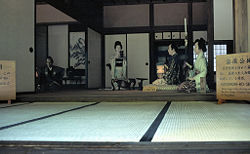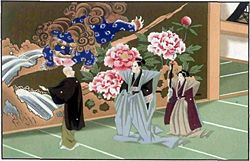Daimyo
The daimyo (大名 daimyō) (daimyō ▶) were the most powerful feudal rulers from the 10th century to the 19th century in Japan. The term "daimyo" literally means "great name." From the shugo of the Muromachi period through the sengoku to the daimyo of the Edo period, the rank had a long and varied history. The term "daimyo" is also sometimes used to refer to the leading figures of such clans, also called "lord". It was usually, though not exclusively, from these warlords that a shogun arose or a regent was chosen.
The daimyo usually wore purples, ranging from dark to light depending on how high ranked they were. Dark and light purple preceded dark and light green, dark and light red, and finally black. The very highest daimyo were considered to be nobles.
Daimyo in the Edo period
After the Battle of Sekigahara in the year 1603 that marked the beginning of the Edo period, shogun Tokugawa Ieyasu reorganized roughly 200 daimyo and their territories, formerly provinces (kuni), into the han, and rated them based on their production of rice. Daimyo were those who headed han assessed at 10,000 koku (50,000 bushels) or more. Ieyasu also categorized the daimyo according to how close they were to the ruling Tokugawa family, who were known for their bravery: shinpan, who were related to the Tokugawa, the fudai, who had been vassals of the Tokugawa or allies in the battle, and the tozama, who opposed the Tokugawa but were defeated.
Around 1800, there were approximately 170 daimyo in Japan.
The shinpan were collaterals of Ieyasu, such as the Matsudaira, or descendants of Ieyasu other than in the main line of succession. Several shinpan, including the Tokugawa of Owari (Nagoya), Kii (Wakayama) and Mito, as well as the Matsudaira of Fukui and Aizu, held large han.
A few fudai daimyo, such as the Ii of Hikone, held large han, but many were small. The shogunate placed many fudai at strategic locations to guard the trade routes and the approaches to Edo. Also, many fudai daimyo took positions in the Edo shogunate, some rising to the position of rōjū. The fact that fudai daimyo could hold government positions while tozama, in general, could not was a main difference between the two.
Tozama daimyo held large fiefs, with the Kaga han of Ishikawa Prefecture, headed by the Maeda clan, assessed at 1,000,000 koku. Other famous tozama clans included the Mori of Chōshū, the Shimazu of Satsuma, the Date of Sendai, the Uesugi of Yonezawa, and the Hachisuka of Awa. Initially, the Tokugawa regarded them as potentially rebellious, but for most of the Edo period, marriages between the Tokugawa and the tozama, as well as control policies such as sankin kotai, resulted in peaceful relations.
Sankin kōtai
Sankin kōtai ("alternate attendance") was the system whereby the Tokugawa forced all daimyo to spend every other year at the Tokugawa court in Edo, and maintain their family members in Edo when they returned to their han. This increased political and fiscal control over the daimyo by Edo. As time went on in the Tokugawa period, many other systems of controlling the daimyo were put into place, such as mandatory contributions to public works such as road building. In addition, daimyo were forbidden to build ships and castles, and other shows of military power were often tightly controlled.
Upset by these controls, and often in bad economic situations because of things like sankin kotai, forced support of public works, and extravagant spending, several daimyo sided against the Tokugawa Shogunate during the Meiji Restoration. In 1869, the year after the Meiji Restoration, the daimyo, together with the kuge, formed a new aristocracy, the kazoku. In 1871, the han were abolished and prefectures were established, thus effectively ending the daimyo era in Japan.
See also
- History of Japan
- Sankin-kotai
- Han (Japan)
ar:دائي-ميو bg:Даймио ca:Dàimio cs:Daimjó da:Daimyo de:Daimyō et:Daimjo es:Daimyō eo:Daimio fr:Daimyo id:Daimyo it:Daimyō he:דאימיו nl:Daimyo ja:大名 pl:Daimyō pt:Daimyo ro:Daimyo ru:Даймё su:Daimyo fi:Daimio sv:Daimyo tr:Daimyo uk:Даймьо wuu:大名 zh:大名 (称谓) zh-classical:大名
Credits
New World Encyclopedia writers and editors rewrote and completed the Wikipedia article in accordance with New World Encyclopedia standards. This article abides by terms of the Creative Commons CC-by-sa 3.0 License (CC-by-sa), which may be used and disseminated with proper attribution. Credit is due under the terms of this license that can reference both the New World Encyclopedia contributors and the selfless volunteer contributors of the Wikimedia Foundation. To cite this article click here for a list of acceptable citing formats.The history of earlier contributions by wikipedians is accessible to researchers here:
The history of this article since it was imported to New World Encyclopedia:
Note: Some restrictions may apply to use of individual images which are separately licensed.

